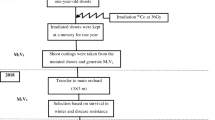Abstract
IN 1944 it was reported1 that young, green oats, grown in the South Island of New Zealand, appeared to be actively rachitogenic for sheep during their first winter. Further investigation2, extending over several years and involving feeding trials with most of the commonly grown sheep fodder crops, as well as young mixed pasture and Italian ryegrass, confirmed the earlier results indicating that young green cereals (oats and barley) are strongly rachitogenic. The affected animals showed hypophosphatæmia positively correlated with the degree of rickets which developed, normal serum calcium values, varying degrees of lameness and severe retardation of growth. Chemical analysis of the green cereals invariably showed an adequate phosphorus content and a satisfactorily balanced calcium–phosphorus ratio. Vitamin D, given as cod liver oil twice weekly (45 ml. per sheep), or as a single massive dose of calciferol (25 mgm. in arachis oil), either orally or subcutaneously, was fully effective in preventing rickets and enabling a high winter growth-rate to be maintained. Calciferol in this dosage also brought about a speedy return to normal in affected sheep.
This is a preview of subscription content, access via your institution
Access options
Subscribe to this journal
Receive 51 print issues and online access
$199.00 per year
only $3.90 per issue
Buy this article
- Purchase on Springer Link
- Instant access to full article PDF
Prices may be subject to local taxes which are calculated during checkout
Similar content being viewed by others
References
Fitch, L. W., and Ewer, T. K., Aust. Vet. J., 20, 220 (1944).
Ewer, T. K., and Bartrum, P., Aust. Vet. J., 24, 73 (1948).
Andrews, E. D., and Cunningham, I. J., N.Z. J. Sci. Tech., 27A, 223 (1945).
Filmer, J. F., Rep. Dir.-Gen. N.Z. Dept. Agric., 1949.
Woolley, D. W., Physiol. Rev., 27, 308 (1947).
Mellanby, E., J. Physiol., 61, 24 (1926).
Ershaff, B. H., Physiol. Rev., 28, 107 (1948).
Author information
Authors and Affiliations
Rights and permissions
About this article
Cite this article
EWER, T. Rachitogenicity of Green Oats. Nature 166, 732–733 (1950). https://doi.org/10.1038/166732a0
Issue Date:
DOI: https://doi.org/10.1038/166732a0
This article is cited by
-
A new mechanism for induced vitamin D deficiency in calcium deprivation
Nature (1987)
-
Rachitisprophylaxe und Rachitismorbidit�t
Zeitschrift f�r Kinderheilkunde (1953)
-
Antivitamin D Factor
Nature (1951)
Comments
By submitting a comment you agree to abide by our Terms and Community Guidelines. If you find something abusive or that does not comply with our terms or guidelines please flag it as inappropriate.


